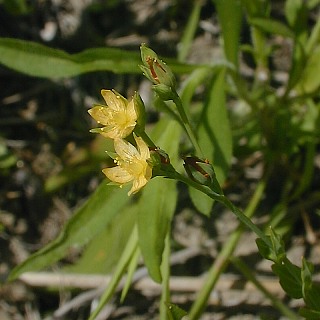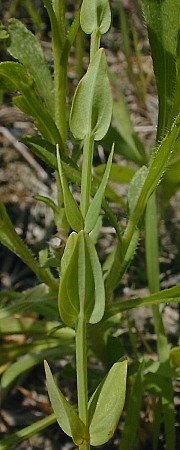Description: This annual or perennial plant is ½–2' tall and unbranched, except toward the apex where the flowers occur. The central stem is green, glabrous, and 4-angled. Pairs of opposite leaves occur at intervals along this stem; they are spreading to ascending, becoming larger toward the middle of the stem. The leaves are up to 1" long and 2/3" (17 mm.) across; they are medium green, ovate-cordate to oval-cordate, smooth along the margins, and hairless. Each leaf clasps the stem at the base and tapers gradually to a blunt tip. The upper surface of each leaf has 3-7 veins.

The central stem terminates in a branching
inflorescence on a fairly long peduncle; the overall size of this
inflorescence depends on the robustness of the individual plant. Each
branch of this inflorescence terminates in a small cyme (flat-headed
cluster) of flowers. The bracts of this inflorescence are small, green,
and linear. Each flower is about ¼" across; it has 5 yellow petals, 5
green sepals, a central ovary with 3 short styles, and 6-12 stamens.
The sepals are lanceolate to linear-lanceolate in shape. The blooming
period occurs during the summer. Each flower is replaced by a seed
capsule that is ovoid-conical and about 4 mm. (1/6") long; it contains
many small seeds. The seeds are light brown, narrowly oblongoid, and
flattened. The root system consists of a taproot and secondary fibrous
roots.
Cultivation:
The preference is full to partial sun, wet to moist conditions, and
soil that is muddy, peaty, or sandy.

Range & Habitat:
Clasping-Leaved St. John's Wort is widely scattered across Illinois and
uncommon (see Distribution
Map). It is native to the state. This species is also
uncommon in other states across
its northern range (e.g., Ohio,
Pennsylvania, & New York), although it may be more common in
some states of the southeastern United States. Habitats include moist
sandy savannas, low sandy
areas along rivers, marshes, and edges of ponds. In sandy savannas,
occasional disturbance (wildfires, removal of trees, etc.) is
beneficial if it reduces the density of woody vegetation.
Faunal Associations:
Bees collect pollen from the flowers. Some insects that feed on Hypericum
spp. include the leaf beetle Pachybrachis relictus,
the caterpillars of the butterfly Strymon melinus
(Gray Hairstreak), and the caterpillars of the moth Nedra
ramosula (Gray Half-Spot). The foliage of many Hypericum
spp. is somewhat toxic to mammalian herbivores, but there is
little specific information in this regard for Clasping-Leaved St.
John's Wort.
Photographic Location:
The edge of a dried-up marsh in Jasper County, Illinois. Only a single
small plant of this species was observed in the area.
Comments:
This little-branched plant is easy to overlook as the flowers are quite
small. It is one of several small-flowered Hypericum spp.
in Illinois, about which little is known. Mohlenbrock (1978) describes
this species as an annual, but other authorities regard it as a
perennial. Clasping-Leaved St. John's Wort resembles Hypericum
mutilum, but this latter species is more branched, its
peduncles are shorter, and its leaves are more obtuse toward their
tips. Another similar species, Hypericum boreale,
also branches readily, its leaves are oval-ovate, and its floral bracts
are more leafy and broad. Two other species in Illinois, Hypericum
canadense and Hypericum majus, have
leaves that are linear to lanceolate in shape and their seed capsules
are longer (8 mm. or more); the latter species also has larger flowers
than Clasping-Leaved St. John's Wort. Other commonly encountered
species of St. John's Wort, like Hypericum punctatum
or Hypericum sphaerocarpum, have larger flowers
that are at least 1/3" (8 mm.) across. In making these distinctions, it
is
helpful to examine the text and line drawings of Mohlenbrock (1978).